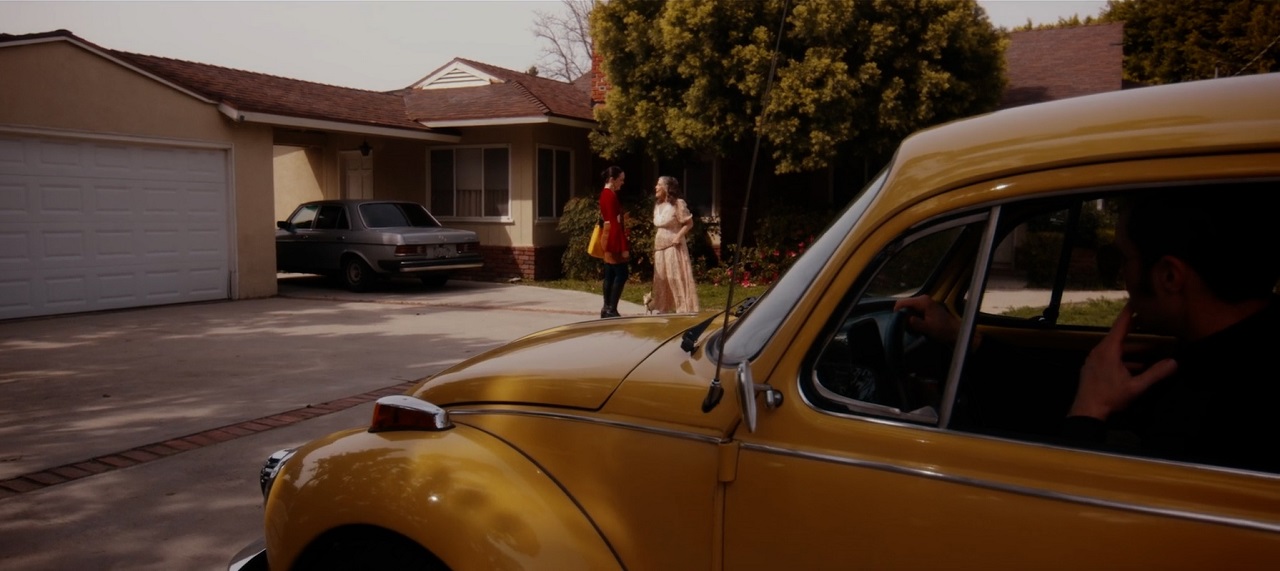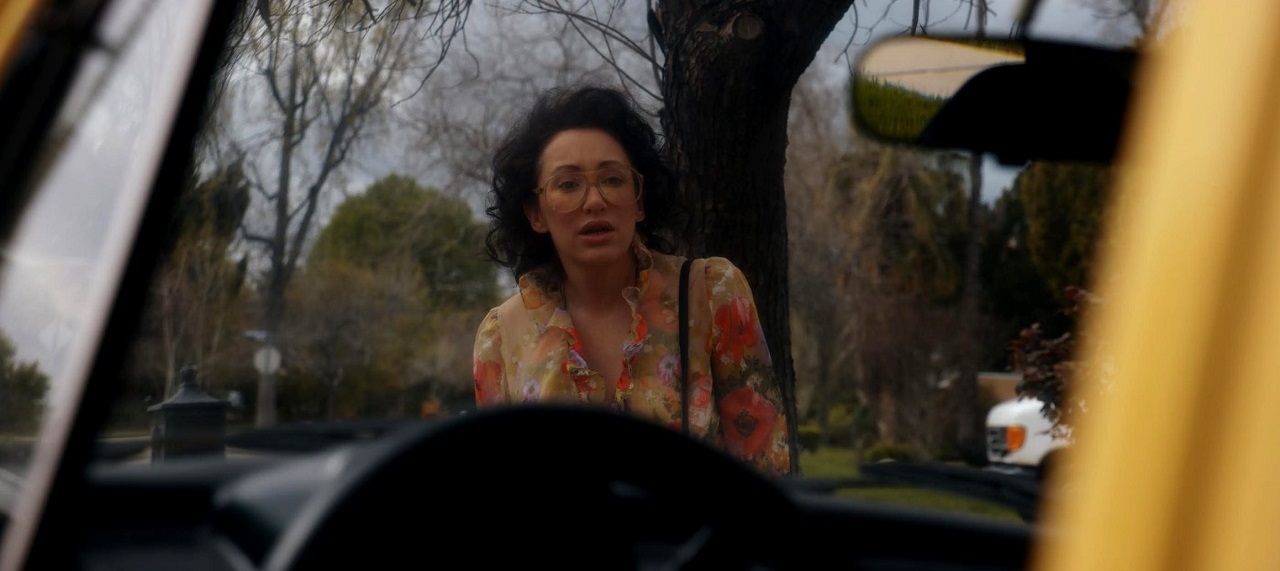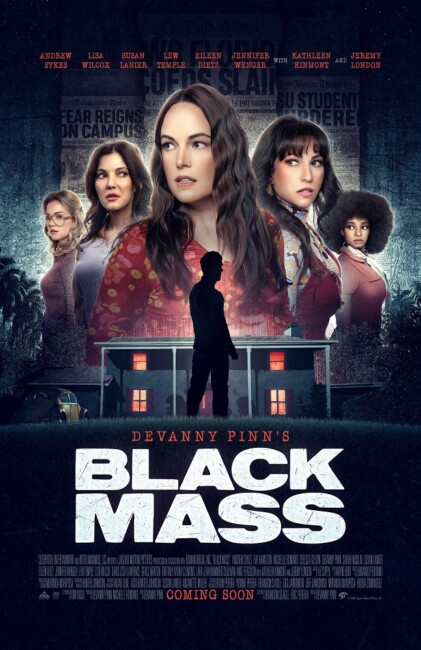USA. 2023.
Crew
Director/Story – Devanny Pinn, Screenplay – Eric Pereira & Brandon Slagle, Producers – Devanny Pinn & Michelle Romano, Photography – Noah Luke, Music – Fernando Perdomo, Visual Effects – Frank Miminski, Special Effects – Oliver Poser, Production Design – Mariposa Miranda. Production Company – Cleopatra Entertainment/Nitro Maximus/Jaguar Motion Pictures/Roman Media, Inc.
Cast
Andy Sykes (Me/Ted Bundy), Eva Hamilton (Lori Lennon), Michelle Romano (Meredith Baker), Sarah Nicklin (Charlotte Turner), Devanny Pinn (Kelly King), Chelsea Gibson (Karla Coleman), Jennifer Wenger (Nancy), Kathleen Kinmont (Brenda), Jeremy London (Patrick), Lew Temple (Detective O’Connor), Lisa Wilcox (Darcy)
Plot
January 14, 1978. Ted Bundy has escaped from police custody and is in Tallahassee, Florida. Bundy stakes out the Delta Phi Sigma sorority house. In the small hours of the morning, Bundy sneaks into the sorority and brutalises and kills several of the girls.
Ted Bundy (1946-89) was an American serial killer. During the years he was active, Bundy killed some thirty women (likely more than that) between Oregon, Utah, Colorado and Florida, usually strangling them and burying their bodies. He was eventually arrested for third and final time in 1978 and underwent a high-profile trial where he was found guilty and sentenced to execution by electric chair in 1989.
Bundy has had a considerable afterlife on film. There have been a number of films portrayals of him from Matthew Bright’s Ted Bundy (2002) starring Michael Reilly Burke; The Stranger Beside Me (2003) starring Billy Campbell; the low-budget Bundy: An American Icon (2009) starring Corin Nemec; Joe Berlinger who made both the documentary series Conversations with a Killer: The Ted Bundy Tapes (2019) and the film Extremely Wicked, Shockingly Evil and Vile (2019) starring Zec Efron as Bundy in tandem with one another; and the low-budget Ted Bundy: American Boogeyman (2021) starring Chad Michael Murray
Devanny Pinn is an actress who has maintained a reasonable career appearing in mostly B-budget genre films – see Devanny Pinn for a listing her works as actor. Pinn has made most of her films in conjunction with director Brandon Slagle, beginning with his second film ViViD (2011). (Slagle also writes and produces here, as well as appears on screen as something called The Entity). Pinn had previously directed the short film Cathartic (2011) and makes her feature-length directorial debut with The Black Mass.

Devanny Pinn focuses on only one chapter of the Ted Bundy story – the attack on Chi Omega sorority house at Florida State University on January 15, 1978. This was the point after Bundy had made his second escape from jail in Aspen, Colorado in December 1977 and had fled to Florida, where he was hiding under an assumed name using stolen ids. Bundy entered the sorority house in the small hours of the morning where he brutalised and sexually assaulted four girls, killing two of them. He fled the scene and then broke into a nearby apartment and attacked but did not kill another girl. A month later, Bundy was pulled over for driving a stolen vehicle and was arrested. This led to the high-profile televised trial where he was found guilty and sent to the electric chair.
Devanny Pinn does surprisingly well when it comes to keeping to the facts of the case (usually a problem when it comes to lower-budgeted adaptations of True Crime stories). The names of the victims and the sorority have been changed. But we get all the other essential parts of the story true to the Tallahassee chapter of Bundy’s story – his living in a motel; his theft of wallets and id cards; the victimology and detail of the attack on the sorority from his use of a log to batter victims to his biting them; his being forced to flee the sorority when the headlights of a car came; and then the attack on another victim nearby where he garrotted her. I did wonder whether the iconic Bundy yellow Volkswagen Beetle was part of the Bundy in Florida chapter or not but apparently it was.
Brandon Slagle mostly makes B movies and I wondered whether The Black Mass was going to be in the same vein, but I was quite surprised with what Devanny Pinn ended up doing. She has a unique directorial focus where Bundy is almost a character who is never seen. In the role, Andy Sykes is shown with his face and figure at the side of the frame, or the camera looking over his shoulder. There are even times when the camera directly takes his point-of-view. On the credits, Sykes is only credited as ‘Me’ – the sole point Bundy’s name is mentioned is by the police as they arrive at the sorority house at the very end where Sykes turns and we see his face directly for the first time (a dramatic licence as Bundy’s responsibility for the attack was not determined until several weeks later after his arrest for driving a stolen vehicle and items taken from the girls were found). This is an interesting effect where the camera is almost in second-person mode, placing the viewer inside Bundy’s shoes as we watch him go about the attacks. Pinn makes the point in the end credits of dedicating the film to the victims of the sorority attacks and including several title cards about the changes they affected to Florida victim’s law. She makes her point clear as the final card comes up “To those affected by the actions of Ted Bundy. We see you, not him”

Devanny Pinn also shows a small mastery of incidental dialogue. The Black Mass is often filled with small vignettes of characters talking about their lives as Bundy peeps in through the sorority house windows or sits observing girls at a bar. It is not the sort of dialogue that will rival a Tarantino but it gives a good flavour of the era. The only scene one feels was unnecessary was one where Bundy is in a bar and turns on a woman calling her a bitch and then sits staring at a group of girls until he is thrown out for … staring at them. I mean, Bundy is such a notoriously evil figure, did the film have to include a scene that tries to rewrite him as an incel too? Not to mention Bundy has a reputation as being charming so the inclusion of such a scene that shows him as socially awkward seems out of place.
Pinn also holds little back when it comes to the horror aspect. There is a scene that may well be an unnecessary one but holds a fairly out there kick to it where Bundy is peeping in on a girl taking a shower where her soaping herself turns into her gouging the skin of her back and then a hand dips into what looks the stump of a neck after her head has been severed. Pinn also displays a surprising brutality and savagery during the attack on the sorority girls and holds little back.
Devanny Pinn also appears on screen as one of the sorority girls – she’s the one in paisley dress and glasses – although it is hard to tell as the girls get no individuation. The film also includes a number of interesting genre cameos. There’s Kathleen Kinmont, a B movie actress of the 1980s with small parts in films like Halloween 4: The Return of Michael Myers (1988) and Bride of Re-Animator (1990) among others, who plays the barmaid at the bar where Bundy gets thrown out. There is also Lisa Wilcox, best known as Alice in A Nightmare on Elm Street IV: The Dream Master (1988), who plays the den mother at the sorority. In addition, Jeremy London has an amusing cameo as the clerk of a convenience store in the opening scene.
I also wondered what the relevance of the title The Black Mass was, Not be confused with the Johnny Depp film Black Mass (2015), which was also a true crime work, it seems a title more appropriate to a film about The Occult and Black Magic or Devil Worship.
Trailer here


